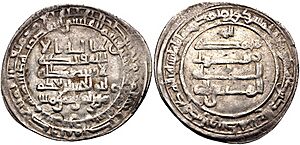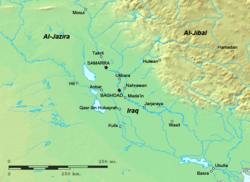Bajkam facts for kids
Quick facts for kids
Abū al-Husayn Bajkam al-Mākānī
|
|
|---|---|
| أبو الحسين بجكم المكاني | |

Silver dirham of Al-Muttaqi AH 329 (940/941 CE), with the names of Caliph al-Muttaqi and Bajkam
|
|
| amir al-umara of the Abbasid Caliphate | |
| In office September 938 – 21 April 941 |
|
| Monarch | al-Radi, al-Muttaqi |
| Preceded by | Muhammad ibn Ra'iq |
| Succeeded by | Kurankij |
| Personal details | |
| Died | 21 April 941 |
Abū al-Husayn Bajkam al-Mākānī, often called Bajkam, was a powerful Turkish military leader. He worked for the Abbasid Caliphate, a large Islamic empire. Bajkam started his career as a ghulam, which was a special military slave. He joined the Abbasid Caliphate after the Ziyarid ruler Mardavij was killed in 935.
For five years, Bajkam was a very important person in the Caliphate's capital, Baghdad. He was given the title amir al-umara, meaning "commander of commanders". This title gave him almost complete control over the Caliphate. He even had power over the caliphs al-Radi and al-Muttaqi. Bajkam faced many challenges from rivals like Muhammad ibn Ra'iq and the Baridis. But he managed to stay in power until he died. He was killed by a group of Kurds during a hunting trip in 941. Bajkam was known for his strong leadership and for supporting smart people in Baghdad. His death caused a lot of trouble and fighting in Baghdad.
Contents
Bajkam's Early Military Life
We don't know much about Bajkam's early life. He was a Turk. He began as a ghilman (a military slave) for a high-ranking official. This official worked for a warlord named Makan ibn Kaki in northern Iran. Later, Makan received Bajkam as a gift. Makan trained and educated young Bajkam. Bajkam was so thankful that he took Makan's name as part of his own.
After Makan was defeated by Mardavij, Bajkam joined Mardavij's army. Mardavij founded the Ziyarid dynasty. He controlled large areas like Daylam and Jibal. However, Mardavij treated his ghilman badly. Because of this, they killed him in January 935. Bajkam might have been involved in this event.
After Mardavij's death, many ghilman left. Bajkam and his friend Tuzun led a large group. They first offered their services to a local governor. Then, they went to the Abbasid court in Baghdad. At first, the Caliph's guards didn't want them. But soon, Bajkam and his men joined Muhammad ibn Ra'iq's army. Ibn Ra'iq was the governor of Basra and Wasit in southern Iraq. Bajkam became known as Bajkam Ra'iqi. He built a strong army with his own followers and other Turkish and Daylamite soldiers.
In November 936, Caliph al-Radi (who ruled from 934 to 940) gave Ibn Ra'iq a new title. This was amir al-umara, or "commander of commanders". This title gave Ibn Ra'iq almost total power over the Caliphate. Other governors and powerful groups in Baghdad didn't like this. Ibn Ra'iq used Bajkam and his Turkish soldiers to fight them. With their help, he defeated the Caliph's guards. In February 937, Bajkam was rewarded. He became the chief of police and governor of the eastern provinces.
Bajkam then faced a difficult war against Abu Abdallah al-Baridi. Al-Baridi was the ambitious governor of Ahwaz. He wanted to replace Ibn Ra'iq. Al-Baridi's family was from Basra. They had worked for the Abbasids for a long time. Ibn Ra'iq lost Basra to the Baridis. But Bajkam saved the day. He won two big battles, even though he had fewer soldiers. This allowed him to take control of Khuzistan.
Al-Baridi then asked for help from the powerful Buyid dynasty ruler, Ali ibn Buya. Ali's brother Ahmad soon took over Khuzistan. Ibn Ra'iq promised Bajkam control of the province if he could get it back. But Bajkam was pushed back by the Buyid forces. He retreated to Wasit.
Bajkam ignored Ibn Ra'iq's orders to retake Khuzistan. He stayed in Wasit and started planning to remove Ibn Ra'iq from power. Bajkam looked for allies. He offered to make the Baridis governors of Wasit. He also got secret support from Caliph al-Radi himself. This was through a former high official, Ibn Muqla. Ibn Muqla wanted revenge on Ibn Ra'iq. In September 938, Bajkam led his troops from Wasit to Baghdad. Ibn Ra'iq tried to stop him by flooding the land. But Bajkam's army entered Baghdad easily. Caliph al-Radi immediately gave Bajkam the title of amir al-umara.
Bajkam: Commander of Commanders
Even though Caliph al-Radi had little real power, he and Bajkam had a good relationship. Al-Radi praised Bajkam for his strict discipline. He called Bajkam his "protégé" (someone he helped and guided). Al-Radi liked that Bajkam respected his position as Caliph. He promised to support Bajkam.
In late 938, Bajkam and the Caliph went to fight Hasan ibn Abdallah. Hasan was a powerful ruler in Mosul. He had stopped sending money from his province to Baghdad. Bajkam's army captured Mosul. But Hasan escaped to a far-off part of his land. Bajkam's soldiers couldn't catch him. Meanwhile, the local people in Mosul fought against the Caliph's troops. Ibn Ra'iq used Bajkam's absence to take control of Baghdad. He brought in a group called the Carmathians.
Because of these problems, Bajkam had to make deals. The Hamdanids (Hasan's family) got their province back. In return, they paid their overdue taxes. Ibn Ra'iq was given control of several provinces. These were also claimed by the Ikhshidids of Egypt. This deal allowed Bajkam and the Caliph to return to Baghdad in February 939.
Bajkam now had control over Baghdad. He then turned to face the Buyids. To do this, he made his ties with the Baridis of Basra stronger. He gave them Wasit, as he had promised. He also made Abu Abdallah al-Baridi a high official at the Abbasid court. However, al-Baridi stayed in Wasit and didn't come to Baghdad. Finally, Bajkam married one of al-Baridi's daughters. Neither side fully trusted the other. Bajkam reportedly said his father-in-law was like a "devil." But the agreement brought a fragile peace to Iraq.
Bajkam had mixed success against the Buyids. Wasit was saved from their attacks. The Baridis also won a battle in Susiana. But an army sent into Jibal was crushed by the third Buyid brother, Hasan. The alliance with the Baridis quickly broke down. Al-Baridi still wanted to replace Bajkam. Bajkam knew this. In August 940, Bajkam removed al-Baridi from his official position. He then attacked Wasit. The Baridis left without a fight. At the same time, Baghdad was in chaos. Religious violence was common. Strict members of the Hanbali school forced their beliefs on everyone.
In December 940, Caliph al-Radi died. Bajkam was still in Wasit. But he sent his secretary to Baghdad. The secretary gathered important Abbasid leaders. They chose al-Muttaqi (who ruled from 940 to 944) as the new Caliph. Al-Muttaqi was al-Radi's brother. Bajkam also sent a slave to the dead Caliph's palace. He wanted to get valuable items, including a famous pearl called al-Yatimah. He also got three female slaves from the palace. He remembered their singing from his earlier visits to the Caliph.
One of al-Muttaqi's first actions was to confirm Bajkam as amir al-umara. Even with this support, Bajkam still faced opposition. Many provincial governors, including al-Baridi, were against him.
Bajkam's Death and What Happened Next
Bajkam started a campaign against al-Baridi in early 941. At first, Bajkam's generals were defeated by the Baridis. So, Bajkam left Wasit to lead the army himself. On his way, he learned that his generals had won a big victory. He decided to return to Wasit. On April 21, 941, while traveling, he went on a hunting trip. He and his group met some Kurdish bandits. During a short fight, Bajkam was killed. One of the Kurds stabbed him in the back with a spear.
Bajkam's sudden death left a power vacuum in Baghdad. The Daylamite and Turkish soldiers disagreed. The Daylamites joined the defeated al-Baridi. With their help, al-Baridi marched on Wasit and Baghdad. He captured them. But he was soon forced to leave because of the disorder he caused. A Daylamite chief named Kurankij took over Baghdad. But he ruled very harshly. Caliph al-Muttaqi asked the former amir al-umara, Ibn Ra'iq, for help.
Ibn Ra'iq soon took back control of Baghdad. But the political problems didn't stop. Again, al-Baridi captured the city. Ibn Ra'iq fled with the Caliph to Mosul. From there, the Hamdanid rulers helped them get Baghdad back. The Hamdanid ruler Hasan ordered Ibn Ra'iq's assassination. Then, Hasan was made amir al-umara. He was given the title Nasir al-Dawla, meaning "Defender of the Dynasty." In 943, the Hamdanids had to retreat to Mosul. This happened when Tuzun, one of Bajkam's officers, took power with military support. The next year, Tuzun captured, blinded, and removed al-Muttaqi from power. He then became amir al-umara. The Caliph's brother, al-Mustakfi (who ruled from 944 to 946), became the new Caliph. The fight for control of the Caliphate ended in 945. That's when the Buyid ruler Ahmad took over as amir al-umara. He was given the title Mu'izz al-Dawla. This started a long period of Buyid control over Baghdad and Iraq. It lasted until the Seljuk conquest in the 1050s.
Bajkam's Personality
Even though Bajkam started as a slave, he was educated. He knew Arabic, though he was shy about speaking it. Smart people respected him. He liked to spend time with scholars like al-Suli and the doctor Sinan ibn Thabit. We learn about his personality from their writings.
According to a researcher named Marius Canard, Bajkam "wanted power and money." He would use tricks and even torture to get what he wanted. He could be cruel. But he was also very brave. He was also more honest than Ibn Ra'iq. Bajkam cared about the people he ruled. The people of Wasit especially remembered him fondly.
See also
- Al-Mustakfi
- Muhammad ibn Ra'iq
- Azjur al-Turki
- Wasif al-Turki
- Ashinas
- Bugha al-Kabir
- Bugha al-Sharabi
- Tuzun (amir al-umara)
- Muzahim ibn Khaqan
- Itakh
- Utamish
- Salih ibn Wasif
- Ahmad ibn Tulun
Sources
- Bowen, Harold (1928). The Life and Times of ʿAlí Ibn ʿÍsà, ‘The Good Vizier’. Cambridge: Cambridge University Press. OCLC 386849. https://archive.org/details/in.ernet.dli.2015.76926.
- Busse, Heribert (1975). [Bajkam at Google Books "Iran under the Būyids"]. [Bajkam at Google Books The Cambridge History of Iran, Volume 4: From the Arab Invasion to the Saljuqs]. Cambridge: Cambridge University Press. pp. 250–304. ISBN 0-521-20093-8. Bajkam at Google Books.
- Canard, Marius (1960). "Badjkam". The Encyclopaedia of Islam, New Edition, Volume I: A–B. Leiden: E. J. Brill. 866–867. DOI:10.1163/1573-3912_islam_SIM_101.
- Mottahedeh, Roy P. (2001). [Bajkam at Google Books Loyalty and leadership in an early Islamic society] (Revised ed.). London: Tauris. ISBN 1860641814. Bajkam at Google Books.
- Qaddūmī, Ghādah Hijjāwī (1996). [Bajkam at Google Books Book of Gifts and Rarities: Kitāb al-hadāyā wa al-tuạf]. Forewords by Oleg Grabar and Annemarie Schimmel. Cambridge, Mass.: Harvard University Press. ISBN 0932885136. Bajkam at Google Books.
- Shalem, Avinoam (1997). [Bajkam at Google Books "Jewels and Journeys: The Case of the Medieval Gemstone Called al-Yatima"]. Muqarnas XIV. Bajkam at Google Books.
| Preceded by Muhammad ibn Ra'iq |
amir al-umara of the Abbasid Caliphate September 938 – 21 April 941 |
Succeeded by Kurankij |


